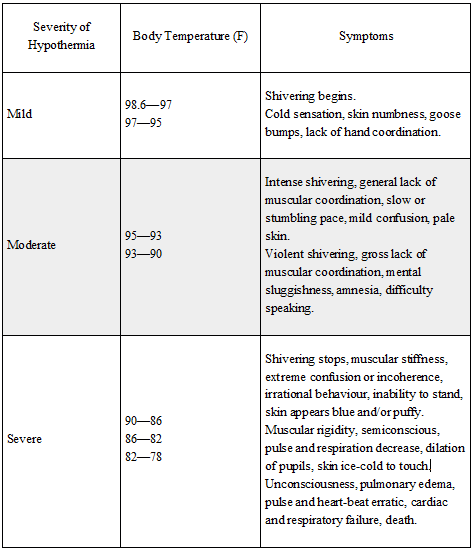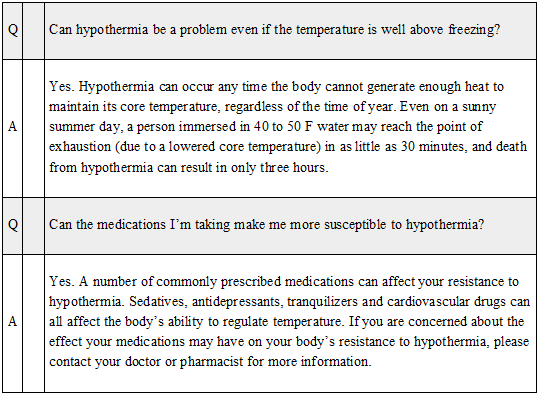Hypothermia Symptoms and Treatment – Quick Tips
Learn how to treat, prevent and recognize the symptoms of hypothermia.
Anyone who works outdoors in cold weather or participates in cold weather activities faces the risk of hypothermia. Unfortunately, the warning signs of hypothermia can go unnoticed by people unfamiliar with the condition. This problem is compounded by the fact that hypothermia can affect reasoning and judgment. Taken together, these factors can quickly lead to a life-or-death situation.
Definition
Hypothermia occurs when an individual’s core body temperature decreases to a level where muscular and cerebral functions become impaired. The most common cause of this loss of body temperature is exposure to cold and/or wet conditions. When exposed to cold conditions, the body can lose heat through a variety of routes. These include conduction (contact with cold or wet objects, such as snow or wet clothing), convection (heat being carried away from the body by wind, i.e., wind chill) and evaporation (sweating and respiration). Once the body’s core temperature begins to drop, the symptoms of hypothermia will begin to appear.
Hypothermia Recognition
The symptoms of hypothermia are varied and depend on the body’s core temperature. A person suffering from a mild case may exhibit shivering and a lack of coordination, while a person suffering from severe hypothermia may be incoherent, exhibiting muscular rigidity and possible cardiac arrest.
The chart below shows common symptoms and corresponding treatments that can be administered in the field:

Hypothermia Treatment
When the signs of hypothermia are detected, it is critical to begin treatment immediately—even in mild cases. The first and most important step is to eliminate the victim’s exposure to cold or wet conditions (seek shelter if outdoors). Additional treatment methods, depending on severity, include:
- Mild hypothermia: Remove all wet clothing and replace it with dry clothing or blankets. Encourage the victim to stay active and to drink a warm (not hot), sweet liquid. Avoid offering liquids containing alcohol and/or caffeine; alcohol can increase heat loss and caffeine tends to cause dehydration.
- Moderate hypothermia: Replace all wet clothing with dry clothing or blankets. Be sure to cover the victim’s head, as this is a major source of heat loss. If the victim is able to swallow without danger, give him/her warm, sweet liquids to drink. Place warm objects, such as hot water bottles, next to the victim’s head, neck, chest and groin to help increase core body temperature; body-to-body contact is also an effective means of warming a victim. Finally, take the victim to a medical facility as soon as possible.
- Severe hypothermia: A person suffering from severe hypothermia can easily be mistaken for dead. Even if the victim is cold, rigid and has no detectable pulse, continue treatment. (There are numerous cases of a seemingly lifeless victim being brought back to full consciousness and good health.) It is vital that a person suffering from severe hypothermia get to a medical facility as quickly as possible, even before treatment is attempted. While waiting for professional assistance, replace the victim’s wet clothing with dry clothing or blankets. Be sure to handle the victim gently, as the heart is susceptible to cardiac arrest when it reaches temperatures below 90 F. If the victim does suffer a cardiac arrest, administer CPR until professional help arrives.
Hypothermia Prevention
You can significantly reduce the risk of hypothermia by taking the following precautions before you head out into cold, wet conditions:
- Wear proper clothing. The ideal clothing for spending extended periods in a cold and/or wet environment includes a breathable layer next to the skin (such as cotton or polypropylene), an insulating middle layer (wool, which continues to insulate even when wet, is a good choice) and a waterproof, but breathable, outer layer (such as nylon or Gore-Tex fabric).
- Stay hydrated when outdoors.
- Use the buddy system to operate as a team when spending time outdoors.
- Familiarize yourself with the signs of hypothermia; early recognition can prevent a life-or-death situation.
Commonly Asked Questions

Additional information on cold weather safety from OSHA:
https://www.osha.gov/dts/weather/winter_weather/index.html
(Rev. 5/2015)
The information contained in this article is intended for general information purposes only and is based on information available as of the initial date of publication. No representation is made that the information or references are complete or remain current. This article is not a substitute for review of current applicable government regulations, industry standards, or other standards specific to your business and/or activities and should not be construed as legal advice or opinion. Readers with specific questions should refer to the applicable standards or consult with an attorney.
Source: Grainger Know How – https://www.grainger.com/know-how